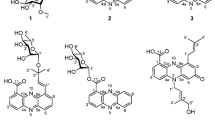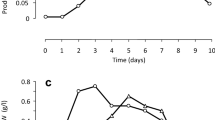Abstract
Solid cultures of the producing strain grown on Bennett medium develop abundant mycelium and intense sporulation. Under these conditions biosynthesis of APHE antibiotics (APHE-1 to -3) is accomplished. Further studies show that APHE-3 is basically produced during spore formation and mostly present in spores, while APHE-1 and APHE-2 are the predominant antibiotics in the mycelium. APHE compounds are present in almost all streptomycetes tested, indicating a possible role in the life cycle of these microorganisms.
Similar content being viewed by others
Author information
Authors and Affiliations
Additional information
Received: 19 July 1999 / Received revision: 22 October 1999 / Accepted: 22 October 1999
Rights and permissions
About this article
Cite this article
Cruz, R., Arias, M. & Soliveri, J. APHE-3, a spore-associated antibiotic of Streptomyces griseocarneus NCIMB 40447. Appl Microbiol Biotechnol 53, 480–483 (2000). https://doi.org/10.1007/s002530051645
Issue Date:
DOI: https://doi.org/10.1007/s002530051645




